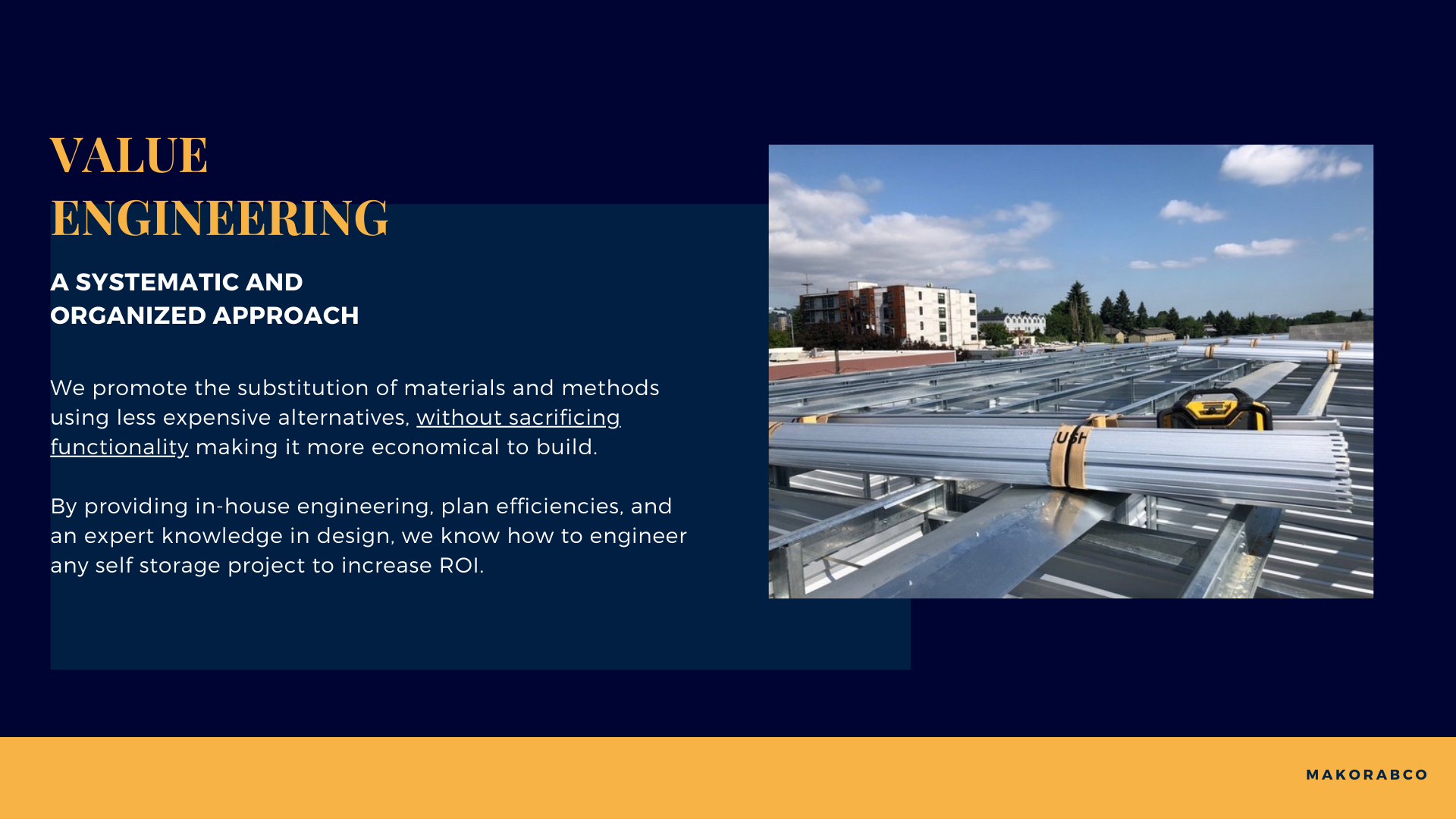
When deciding to build a new self-storage facility, one of the most important parts is the design and engineering aspect of the project. When we hear the word design, there are a lot of different things it could be referring to. It can refer to the general design of the plot, the architectural designs, or the building plans themselves. For this article, we will be referring to the engineering design aspect.
When getting your engineering design created for your project, it has always been important to have a well thought-out and cost-effective plan. With the growing demand and increasing costs associated with construction, developers are turning to value engineering (VE) to enhance performance and reduce costs without compromising the integrity of these facilities.
What is VALUE ENGINEERING? Value engineering is a systematic and organized approach to engineering design that provides the necessary functions in a project at the lowest cost. Value engineering identifies and eliminates unwanted costs, thereby increasing the value for manufacturers and their customers. While value engineering is not something unique to the self-storage industry, it is something used frequently to make sure new facilities are built as economical as possible. At MakoRabco, all our design and engineering are done with value engineering at the forefront.
What does value engineering look like in the design of a self-storage facility? In the context of self-storage facility design, value engineering manifests in various ways. One of the main ways we see this is in the way the actual building itself is designed. For example, instead of employing structural steel braced frame or masonry shear wall as the lateral force resisting system, cold-formed steel shear walls with corrugated steel panels can be used. This alternative accomplishes the same purpose but at a reduced expense. Additionally, value engineering can emphasize the optimization of unit layouts within the new facility. Since the units themselves determine the potential business capacity, it's vital to efficiently utilize available space.
When commissioning a company for engineering designs for your upcoming facility, it's essential to ensure their commitment to value engineering principles. Doing so promises numerous advantages for the facility and the construction journey with the chief advantage being substantial savings in construction and long-term maintenance. By optimizing the use of materials and design, developers can significantly reduce initial and future costs. Value engineering can also lead to improved functionality in the designs that enhance user experience. For instance, an efficient layout can improve accessibility and circulation within the facility. Depending on your focus, sustainability can also be a large byproduct of value engineering. By considering energy efficiency and sustainable materials, value engineering contributes to more eco-friendly self-storage facilities. Finally, the biggest benefit you can see from value engineering is risk mitigation and forecasting. A systematic value engineering process can identify potential risks in the early stages, allowing developers to address them proactively so they do not become an issue further down the line. This helps projects run smoother from start to finish.
When designing from a value engineering mindset, there are some considerations that you should always think about. The first is your material selection for building. Materials make up a significant portion of construction costs. Opt for materials that offer durability, security, and cost-effectiveness. For instance and depending on local requirements that need to be met, a pre-engineered metal building, might be more cost-effective and just as sustainable than a traditional brick and mortar building. As stated above, optimizing the design is also a crucial aspect of value engineering. Instead of generic designs, consider custom solutions that cater specifically to the demographics and needs of the target market. This might mean varying unit sizes or incorporating climate-controlled units based on regional demands. Another aspect to be conscientious of is what technologies are going to be included in the final build. Taking stock of modern technologies such as access control systems, surveillance cameras, and climate control can help minimize the need to retrofit after the building is complete. Finally, it is crucial to involve all stakeholders, from architects to end-users, in the value engineering process. This collective brainstorming can lead to innovative solutions that might not have been apparent from a single perspective.
MakoRabco’s in-house licensed engineers, estimators and designers are experts in the design of self-storage buildings and have the ability to identify costly unit mix layout and details early and suggest alternative solutions for a more economical design. Construction risks can be mitigated thanks to our project managers and erectors, experts on the MakoRabco structure systems, thus the process from engineering and construction is streamlined. So, no matter if you are an architect, general contractor or investor, again, we suggest you engage in the early phase of the self-storage development so that we can assist you every step of the way to develop the most cost-effective design. We can also help re-evaluate structural design that has been designed already.
Here at MakoRabco, we feel that value engineering, when executed correctly, can offer tremendous benefits in the construction and operation of self-storage facilities. By focusing on both the present-day construction costs and the long-term operational expenses, developers can create facilities that are cost-effective, efficient, and sustainable to develop. As the self-storage industry continues to grow, incorporating value engineering principles will be vital in staying competitive and offering customers the best value for their money.
Curious about value engineering for your next self-storage facility?
Click here to learn more!
